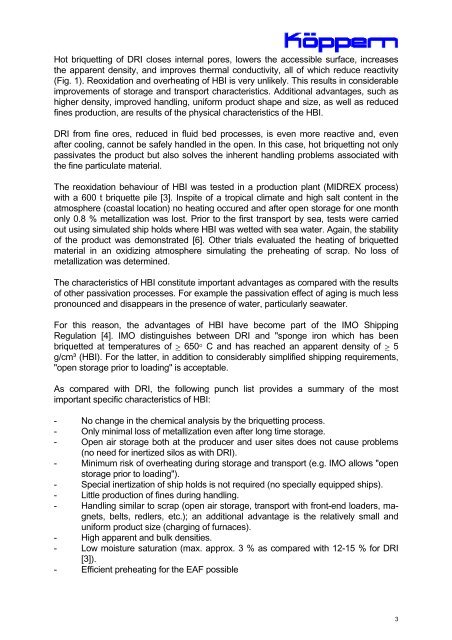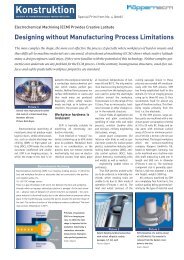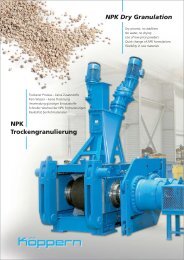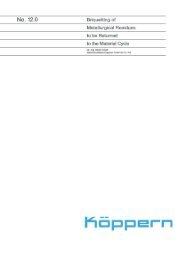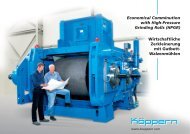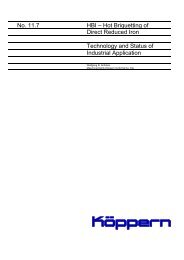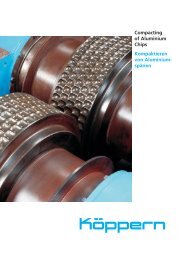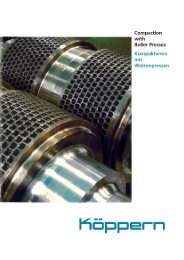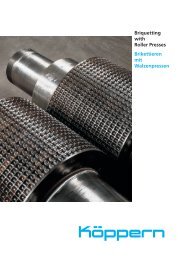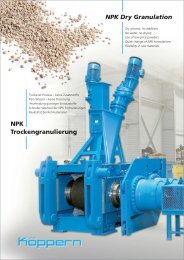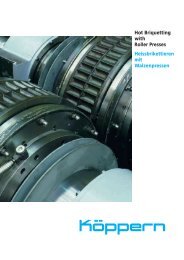Hot Briquetting of - Maschinenfabrik Köppern GmbH & Co. KG
Hot Briquetting of - Maschinenfabrik Köppern GmbH & Co. KG
Hot Briquetting of - Maschinenfabrik Köppern GmbH & Co. KG
You also want an ePaper? Increase the reach of your titles
YUMPU automatically turns print PDFs into web optimized ePapers that Google loves.
<strong>Hot</strong> briquetting <strong>of</strong> DRI closes internal pores, lowers the accessible surface, increases<br />
the apparent density, and improves thermal conductivity, all <strong>of</strong> which reduce reactivity<br />
(Fig. 1). Reoxidation and overheating <strong>of</strong> HBI is very unlikely. This results in considerable<br />
improvements <strong>of</strong> storage and transport characteristics. Additional advantages, such as<br />
higher density, improved handling, uniform product shape and size, as well as reduced<br />
fines production, are results <strong>of</strong> the physical characteristics <strong>of</strong> the HBI.<br />
DRI from fine ores, reduced in fluid bed processes, is even more reactive and, even<br />
after cooling, cannot be safely handled in the open. In this case, hot briquetting not only<br />
passivates the product but also solves the inherent handling problems associated with<br />
the fine particulate material.<br />
The reoxidation behaviour <strong>of</strong> HBI was tested in a production plant (MIDREX process)<br />
with a 600 t briquette pile [3]. Inspite <strong>of</strong> a tropical climate and high salt content in the<br />
atmosphere (coastal location) no heating occured and after open storage for one month<br />
only 0.8 % metallization was lost. Prior to the first transport by sea, tests were carried<br />
out using simulated ship holds where HBI was wetted with sea water. Again, the stability<br />
<strong>of</strong> the product was demonstrated [6]. Other trials evaluated the heating <strong>of</strong> briquetted<br />
material in an oxidizing atmosphere simulating the preheating <strong>of</strong> scrap. No loss <strong>of</strong><br />
metallization was determined.<br />
The characteristics <strong>of</strong> HBI constitute important advantages as compared with the results<br />
<strong>of</strong> other passivation processes. For example the passivation effect <strong>of</strong> aging is much less<br />
pronounced and disappears in the presence <strong>of</strong> water, particularly seawater.<br />
For this reason, the advantages <strong>of</strong> HBI have become part <strong>of</strong> the IMO Shipping<br />
Regulation [4]. IMO distinguishes between DRI and "sponge iron which has been<br />
briquetted at temperatures <strong>of</strong> ≥ 650° C and has reached an apparent density <strong>of</strong> ≥ 5<br />
g/cm³ (HBI). For the latter, in addition to considerably simplified shipping requirements,<br />
"open storage prior to loading" is acceptable.<br />
As compared with DRI, the following punch list provides a summary <strong>of</strong> the most<br />
important specific characteristics <strong>of</strong> HBI:<br />
- No change in the chemical analysis by the briquetting process.<br />
- Only minimal loss <strong>of</strong> metallization even after long time storage.<br />
- Open air storage both at the producer and user sites does not cause problems<br />
(no need for inertized silos as with DRI).<br />
- Minimum risk <strong>of</strong> overheating during storage and transport (e.g. IMO allows "open<br />
storage prior to loading").<br />
- Special inertization <strong>of</strong> ship holds is not required (no specially equipped ships).<br />
- Little production <strong>of</strong> fines during handling.<br />
- Handling similar to scrap (open air storage, transport with front-end loaders, magnets,<br />
belts, redlers, etc.); an additional advantage is the relatively small and<br />
uniform product size (charging <strong>of</strong> furnaces).<br />
- High apparent and bulk densities.<br />
- Low moisture saturation (max. approx. 3 % as compared with 12-15 % for DRI<br />
[3]).<br />
- Efficient preheating for the EAF possible<br />
3


